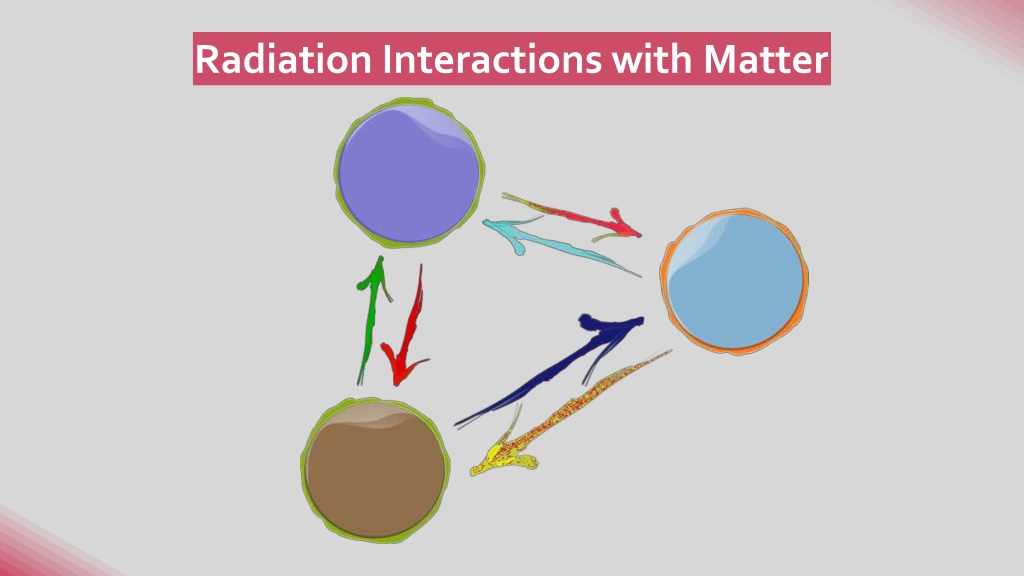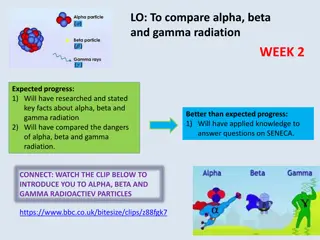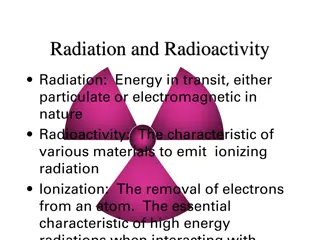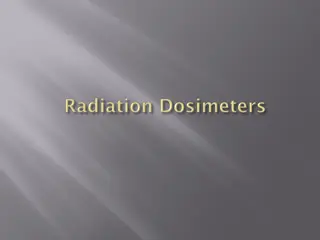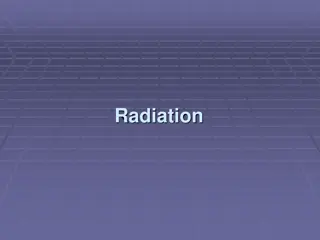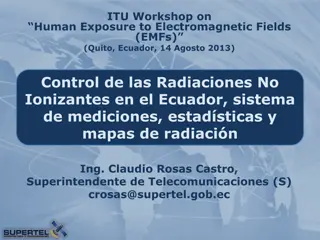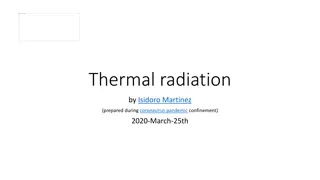Understanding Ionizing Radiation and Its Interactions with Matter
Ionizing radiation interacts with matter in direct and indirect ways, leading to various effects on biological systems. Directly ionizing particles disrupt atomic structures, while indirectly ionizing radiation like electromagnetic waves produce secondary electrons. Alpha particles have high ionization abilities but weak penetration, beta particles penetrate deeper with less energy, and neutrons require hydrogen-rich shielding. Electromagnetic radiation, including gamma rays and X-rays, are massless and penetrate deeply, requiring dense shielding for containment.
Uploaded on Sep 20, 2024 | 0 Views
Download Presentation

Please find below an Image/Link to download the presentation.
The content on the website is provided AS IS for your information and personal use only. It may not be sold, licensed, or shared on other websites without obtaining consent from the author. Download presentation by click this link. If you encounter any issues during the download, it is possible that the publisher has removed the file from their server.
E N D
Presentation Transcript
Types of Interaction with Matter Ionizing radiation may be divided into directly and indirectly ionizing: Direct interaction: particulate radiation ( , and particles) are directly ionizing and disrupt the atomic structure of absorbing matter. Indirect interaction: electromagnetic radiation (X,and rays) are indirectly ionizing because they do not produce biological damage themselves but produce secondary electrons (charged particles) after energy absorption in the matter.
Alpha () particles Positively charged Higher mass particles (2P + 2 N) Lower velocity Highly ionizing Quickly losing their energy Weakly penetrate in body tissue Stopped and fully absorbed by low density material with a thickness of fewmillimeters such as paper, and clothes.
Beta () particles Lower mass with a single negative charge Less energetic Higher velocity than alpha particles Penetrate tissues to a greater depth (skin) Stoppedby plastic material(few centimeters) or metal material (few millimeters).
Neutrons Uncharged(neutral) More penetrated than charged particles Produce ionizing of matter indirectly via secondary events. Travel great distances in air (100s to even 1000s meters), and several meters in solid matters Stopped only with hydrogen rich shielding such as concrete or water.
Electromagnetic radiation (X, and rays) Gamma ray originate from nucleus X-ray originate from electron cloud of atom. Both are photons (massless & uncharged) Progress at the speed of light Deeply penetrate further than alpha & beta Stopped by dense metal, concrete, or earth. Indirectly ionizing They are indirectly ionizing because they do not produce chemical and biological damage themselves but produce secondary electron after absorption their energy by matter.
Sources of Radiation A. NaturalSources B. Man - madeSources 1.Public exposure 1.Cosmic radiation 2.Occupationalexposure 2.Terrestrial radiation 3.InternalSource
Natural Source: Cosmic radiation Charged particles from the sun and stars interact with the earth s atmosphere and magnetic field to produce a shower of cosmic radiation consists of positively charged particles, aswellasgamma radiation. The exposure of an individual to cosmic rays is greater at higher elevations than at sea level because at higher elevations the amount of atmosphere shielding decreases and thusthedoseof cosmicraysincreases.
Natural Source: Terrestrialradiation Ground, rocks, building materials and drinking water contained many radioactive materials such as radium, uranium and thorium which are ingested with food and water. Radon gas is originated from the decay of natural uranium in soil, and when it is inhaled by human emits alpha radiation that cause lung cancer. The dose from terrestrial sources also varies in different parts of the world according to the concentrations of uraniumandthoriumintheirsoil.
Natural Source: Internalradiation We have various radioactive isotopes inside our bodies from birth such as: 1.Potassium-40 2.Tritium (3H) 3.Carbon-14 4.Lead-210 The variation in dose from one person to another is not as great as the variation in dose from cosmic and terrestrial sources.
Man -made Source: 1- Publicexposure The majority of people may exposed to radiation for one or several times during their life from the following sources: a)Medical X-ray for diagnosis (chestX-ray) b)Nuclear medicine for therapy (iodine -131, Technetium - 99, Cobalt-60, andCesium-137) c)Consumer products (tobacco, fuels (gas, coal), ophthalmic glass, televisions, airport X-ray systems, smoke detectors, building & road construction materials, etc.). d)Residual fallout from nuclear weapons testing, shipment, and accidents.
Man -made Source: Occupational exposure Some workers are exposed to artificial sources of radiation commonly used in the manufacturing and service industries such as: 1.Nuclear fuel cycle at a nuclear plant 2.X-raymachines 3.Radiography
The average annual radiation dose from: Natural sources (Radon, Internal, Terrestrial, Cosmic) (82%) Man-made (Medical X-ray, Nuclear Medicine, Consumer Products)(18%)
Types of RadiationUnits 1. Measurement of Decay Rate The amount of radioactive material in a given object contains unstable atoms which are continuously decaying, so the more unstable atoms, the greater the decay rate. This rate of decay is measured by twounits: a)Curie (Ci) is a unit used to measure a radioactivity and related to the decay rate (disintegration rate), so One curie = 2,200,000,000,000 disintegrations per minute (2.2 x 10 dpm). This means that every minute, 2.2 x 10 atoms decay and give off radiation. b)Becquerel (Bq) is a unit also used to measure a radioactivity and one Becquerel is that quantity of a radioactive material that will have 60 dpm. As a result, there are 3.7 x 10 Bq in one curie.
Types of Radiation Units 2.Measurement of Exposure Dose Roentgen (R) measure of how many ion pairs are formed in a given volume of air when it is exposed to radiation only to gamma and x-rays. 3.Measurement of AbsorbedDose a) Rad (Radiation absorbed dose) measure energy absorbed from any type of radiation, but it does not describe biological effects of different radiations. b)Gray (Gy) is a standard international (SI) unit also used to measure absorbed dose, and each 1 Gray = 100 rads.
Types of Radiation Units 4. Measurement of EquivalentDose It is thequantity of radiation dose that is relative to the harm or risk caused by a given dose of radiation when compared to any otherdosesof radiation of any type. Equivalentdose= absorbeddosex qualityfactor (Q) a)Roentgen equivalent man (rem) (1 rem = 1000mrem). b) Sievert (Sv) is standard international (SI) unitalso usedto measure equivalent dose, and each 1 Sievert = 100rem.
Types of Radiation Doses Dose: The amount of radiation you receive and measured by (mrem). Dose Rate (intensity): how fast you receive the dose and measured by (mrem/hr). Biological effectiveness of each type of radiation depend on: 1.Type of radiation 2.Type of tissue 3.Period of time exposure
Types of Radiation Doses 1.Equivalent dose compare biological effectiveness of different types of radiation on the same tissue (absorbed dose quality factor of radiation type) (rem or Sievert). 2.Effective dose estimate risk of radiation in humans (sum of equivalent doses to each organ and tissue factor) (Sievert - Sv) 3.Collective dose is dose received per person X number of persons exposed peryear. 4.Chronic dose is a radiation dose received over a long period of time. 5.Acute dose is a radiation dose received over a short period of time.
